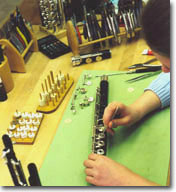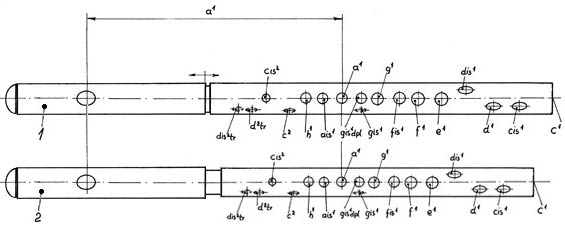
Maintenance and repair service.
We at Braun Flutes & Piccolos are offering an exclusive maintenance and repair service in our own workshop. We are providing this service in order to maintain the personality of your instrument as well as its quality and reliability.
The prices for this work are to be found in the
current price list.
Exact prices, however, cannot be given until the instrument has been seen.

- How do I order an instrument?
To ensure subsequent contact, the best thing is to place your order in writing, by filling out the order form on our website, by e-mail or fax. Upon receipt of your order you will be put on the current waiting list. The order is not binding until the proforma invoice is paid. - Do you have instruments in stock?
We are a small family business and we only make instruments on order. So we do not have any instruments in stock. - What waiting time is to be expected?
The delivery times are subject to seasonal fluctuation. Upon request we can notify you of the possible delivery date. The contact form you can find under “Contact & order form”. - When and how much do I have to pay?
About four weeks before delivery we will contact you to clear up any unresolved issues, and will then send you a proforma invoice. Then the full amount has to be paid. - I play deep. In cold rooms I can not get the intonation high enough. Should I order an instrument
(2) in a higher pitch?
An instrument in a higher pitch would solve the problem ( a¹) but it is not to recommend. Because the notes below the tuned note will be too high and the sounds above the tuned note will be too deep. The drawing below illustrates it with a theoretical extreme case. The problem would only be solved by adjusting the length of the headjoint.
- Is also special mechanism such as high-GA-trill or Cis trill made?
No, because the rare advantages in practice, are not in relation to the disadvantages which act permanently over a wider tonal range. Another disadvantage is the relatively high defect susceptibility, which is particularly evident by the high position of the holes (position near to the trill holes d² and d#²). A disturbing effect is also the big design effort and the associated increase in weight of the Instrument. - They build Piccoli only with split E mechanism, but makes the existence of a split E mechanism to perform the Trill g³-a³ not impossible?
No, it goes without problems. In the table below you will find practical tips for Piccolo. When trill g³-a³ it is recommended to use the g³ the trill with normal grip (without thumb key) to blow and only when following a³ to select the trill fingering. Depending on your personal play one or the other grip is more advantageous.

d³ pianisimo

tr g³-a³

f#³ pianisimo

tr g³-a³
- Which cloths do you recommend to wipe out the piccolo?
I recommend silk cloths, Pongé 05 or 08 density, in size 28x28cm (11" x 11").
These cloths are available in most craft stores and on the Internet at requirements for silk painting. The advantage of these cloths is that they are not fluffy and also in the smaller conical bore they can be pulled through easily, even when they are wet.
 Note: only pull the cloth but never
push it through (how it often is done at the large cylindrical flute). If you push it the danger is that the smaller
bore gets damaged. Also in the headjoint they fill the larger bore well and can thus be optimally wipe out the headjoint.
Note: only pull the cloth but never
push it through (how it often is done at the large cylindrical flute). If you push it the danger is that the smaller
bore gets damaged. Also in the headjoint they fill the larger bore well and can thus be optimally wipe out the headjoint.
- What is the specific measurement for the position of the headjoint cork on your piccolo / small flute?

The cleaning rod with a notch to control the position of the headjoint cork has an uncommon measurement of 8.5 mm. - Due to an accident, the silicone pads of the instrument has been damaged. I need the instrument urgently and can not find
a repair shop that has experience with silicone pads. Which pads can be used as an alternative?

I recommend cork pads as an alternative to the silicone pads.
They have good sound properties. A set pads for piccolo consists of:
(Cup inside x piece) ∅7mm x 2, ∅8mm x 2, ∅9mm x 6, ∅10mm x 4. The thickness should be about 1.7 mm / new model 2 mm. When gluing in the pads, make sure that the pad should protrude approx. 0.5 mm from the lid.
I advise against felt pads (goldbeater’s skin/bladder sheet), as this will cause the instrument to loose its tonal character.
- Can I purchase „A.Braun“ silicone pads from you?
We manufacture our pads exclusively for our own instrument production. As an instrument manufacturer, we don't have the additional capacity to produce more pads and offer them for sale as a standalone product.
Please also note that our pads cannot be glued in using conventional methods. A special process developed by us is required to install our silicone pads. If these pads are used without this process, they may not function optimally. - Is it possible to visit you and try out an instrument to get to know it?
We're rarely asked this question, as the majority of our production is exported. Furthermore, most of our customers who order from us already know our instruments through word of mouth among flutists.
After decades of experience, we saw no reason to build a dedicated room for trying out instruments when building our new workshop, and therefore we don't have such facilities in addition to our existing workshop space.
A customer visit to our workshop simply to get to know an instrument would mean a production stoppage and is therefore unfortunately not possible.
- Where is Egelsbach?
Egelsbach is halfway between Frankfurt and Darmstadt, and about 18 km from Frankfurt airport. You can travel from Frankfurt to Egelsbach by train by taking the -Bahn towards Darmstadt.
-Bahn towards Darmstadt.
Instrument Type
Intstrument
Ident.Nr
Ident.Nr
Attention stolen
A. Braun Piccolo
736
Juni.2012
Berlin
Attention stolen
A. Braun Piccolo
442
Nov.2009
Mannheim
Attention stolen
A. Braun Piccolo
404
Okt.2007
Genf / Schweiz
Attention stolen
A. Braun Flute
076
Nov.2005
Frankfurt am Main
Attention stolen
A. Braun Piccolo
556
Mai.2004
Italien
Lost
A. Braun Piccolo
089
Dec.2003
Lyon/Frankreich
Attention stolen
A. Braun Piccolo
519
Sep.2003
Genf / Schweiz
Attention stolen
A. Braun Piccolo
392
Apr.1991
New Orleans / USA
Copyright: © 2010 - 2025 Anton Braun. All rights reserved.
